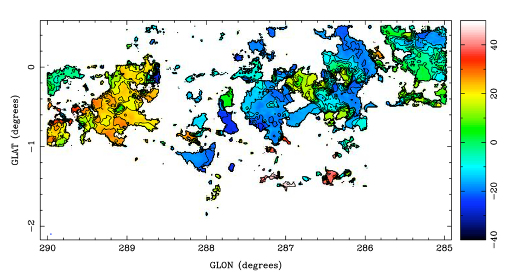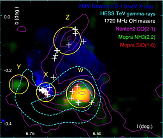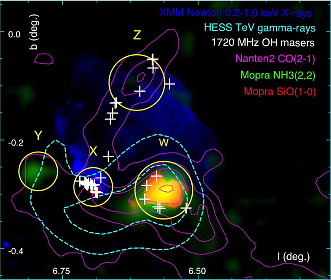Radio continuum
Recent and new radio facilities which observe continuum emission (such as MWA, ASKAP-EMU, and eventually SKA) are providing new data which will work well with forthcoming CTA data in the study of extragalactic gamma-ray sources.
Dark matter
The existence of dark matter has been inferred by a number of indirect means. A further proposed indirect method concerns gamma-rays.
The hypothesis is that photons of very specific gamma-ray energy might be generated via the annihilation of two dark-matter particles. Such photons may be evident as an emission line in gamma-ray spectra.
A definite detection of this characteristic gamma-ray emission would help refine our models of what dark matter actually is- one of the prime physics questions of our time.
Cosmic rays
There are sources of cosmic rays both within and outside our galaxy. Since cosmic rays can interact with gas inside our galaxy to produce gamma-rays that CTA can observe, knowing about the sources and energies of cosmic rays is important to CTA science.
One of the premier facilities for observing cosmic rays is the Pierre Auger Observatory in Argentina, and CTA has close links with this major facility.
Neutrinos
Neutrinos are almost-massless particles which, having no electrical charge, travel in straight lines from their source. Detectors such as IceCube are used to map the distribution of astrophysical sources of neutrinos across the sky, as well as looking for any variation of these sources over time.
However, corellating these neutrino sources with known objects that are observed at other enegies, has been problematic. There is much interest in looking for connections between neutrino and gamma-ray sources, and with the extra sensitivity and resolution that will be offered by CTA, it is hoped that CTA data will be of help in elucidating the nature of sources of neutrinos that are detected by experiments such as IceCube.
Theoretical high-energy astrophysics
CTA-Australia is active in several areas of theoretical high-energy astrophysics. These include
- the formation of jets and relativistic flows associated with AGN, and jet interactions with the surrounding medium;
- charged-particle propagation and interaction within our galaxy's central region;
- propagation of charged particles in the interstellar medium;
- production of gamma-rays from cosmic-rays and electrons.
CTA-Australia's Science
CTA has a number of key science areas to which the facility as a whole will provide substantial increases in our uderstanding.
These cover topics such as the Galactic centre and plane (including the interstellar medium), the Large Magellanic Cloud, galaxy clusters (and dark matter), the highest-energy cosmic rays, star-forming regions, active galactic nuclei, and transient phenomena.
CTA-Australia has interest in a number of these areas, as discussed here.
The Interstellar Medium (ISM)
Many gamma-ray sources are found in our own Milky Way galaxy. Since this is also where the concentration of the ISM is greatest, it is natural to investigate connections between the TeV sources and the ISM.
In particular, the ISM gas provides targets for collisions with cosmic rays, which can lead to the production of gamma-rays by proton-proton interactions and electron-proton interactions
To answer this question, radio telescopes are used to survey the distribution of the ISM, allowing us to look for correlation between the location of gamma-ray sources and material in the ISM.
Radio surveys of the galactic plane are underway (such as MopraGAM, MopraCO and MopraCMZ), at frequencies including those due to carbon monoxide (CO), atomic carbon (C), atomic hydrogen (H), carbon monosulfide (CS), silicon monoxide (SiO) and ammonia (NH3).
Map of CO emission in the constellation Carina, using the Mopra 22-metre telescope. Colours indicate velocity: negative values (blues) indicates gas moving towards Earth, positive values (green-red) indicate gas moving away from Earth. These velocities may be converted into distances from Earth; thus, such a map provides a three-dimensional distribution of gas in the direction shown. "GLAT" and "GLON" are galactic latitude and longitude respectively, in degrees. Image from Rebolledo et al.
These surveys trace the structure of gas and molecular clouds in the ISM; changes in frequency of the various emission lines are used to provide estimates of distance from Earth, allowing the three-dimensional structure of the ISM to be determined.
Gamma-ray emission is found both as diffuse emission in the galaxy, and as individual sources. The enhanced spatial and energy resolution of CTA data will allow individual gamma-ray sources to be examined in unprecendented detail. One particular application of this is the study of dense gas regions, where energy-dependent, small-scale variation in the gamma-ray emission can help elucidate small-scale structure within molecular clouds.
The positional correlation between radio and gamma-ray data for individual sources (such as supernova remnants, and pulsar wind nebulae) allows investigation of galactic cosmic-rays (via the production methods listed earlier) as well as the structure of these sources.
Multi-messenger map of part of the W28 supernova remnant. The area shown is about the same size as the full Moon. Gamma-ray contours (from HESS; see Aharonian et al 2008) and radio data show strong correlation. Image from Maxted et al.
Not only do these radio surveys help us to interpret the result of gamma-ray observations, but they also are useful in their own right. They help to elucidate the structure of our galaxy, the presence of dense molecular clouds which are involved in star formation, the existence of supernova remnants, and many other aspects of the constitution of our galaxy.




